Groundhog
| Groundhog | |
|---|---|
 | |
| Scientific classification | |
| Kingdom: | Animalia |
| Phylum: | Chordata |
| Clade: | Synapsida |
| Class: | Mammalia |
| Order: | Rodentia |
| Family: | Sciuridae |
| Tribe: | Marmotini |
| Genus: | Marmota |
| Species: | M. monax |
| Binomial name | |
| Marmota monax (Linnaeus, 1758) | |
| Subspecies | |
| |
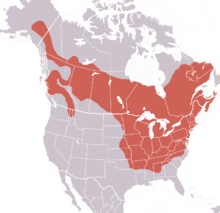 | |
| Groundhog range | |

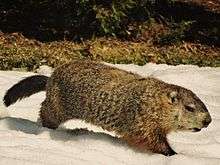
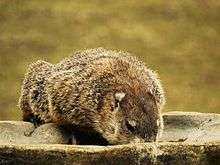
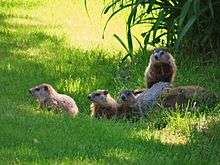
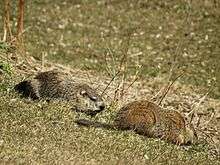
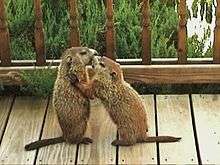

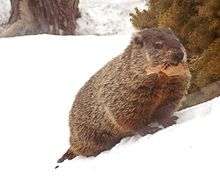
The groundhog (Marmota monax), also known as a woodchuck, or whistlepig,[2] is a rodent of the family Sciuridae, belonging to the group of large ground squirrels known as marmots.[3] The groundhog is also referred to as a chuck, wood-shock, groundpig, whistler, thickwood badger, Canada marmot, monax, moonack, weenusk, and red monk. The name "thickwood badger" was given in the Northwest to distinguish the animal from the prairie badger. Monax was an Indian name of the woodchuck, which meant "the digger".[4]:300–301 Young groundhogs may be called chucklings.[5]:66 Other marmots, such as the yellow-bellied and hoary marmots, live in rocky and mountainous areas, but the groundhog is a lowland creature. It is widely distributed in North America and common in the northeastern and central United States and Canada. Groundhogs are found as far north as Alaska, with their habitat extending southeast to Georgia.[6]
Description
The groundhog is the largest sciurid in its geographical range, typically measuring 40 to 65 cm (16 to 26 in) long (including a 15 cm (6 in) tail) and weighing 2 to 4 kg (4 to 9 lb). In areas with fewer natural predators and large amounts of alfalfa, groundhogs can grow to 80 cm (30 in) and 14 kg (31 lb). Groundhogs are well adapted for digging, with short, powerful limbs and curved, thick claws. Unlike other sciurids, the groundhog's spine is curved, more like that of a mole, and the tail is comparably shorter as well — only about one-fourth of body length. Suited to their temperate habitat, groundhogs are covered with two coats of fur: a dense grey undercoat and a longer coat of banded guard hairs that gives the groundhog its distinctive "frosted" appearance.
Etymology
The etymology of the name woodchuck is unrelated to wood or chucking. It stems from an Algonquian (possibly Narragansett) name for the animal, wuchak.[7] The similarity between the words has led to the popular tongue-twister:
- How much wood would a woodchuck chuck
- if a woodchuck could chuck wood?
- A woodchuck would chuck all the wood he could
- if a woodchuck could chuck wood![8]
Distribution and habitat
The groundhog prefers open country and the edges of woodland, and is rarely far from a burrow entrance. Since the clearing of forests provided it with a much more suitable habitat, the groundhog population is probably higher now than it was before the arrival of European settlers in North America. Groundhogs are often hunted for sport, which tends to control their numbers. However, their ability to reproduce quickly has tended to mitigate the depopulating effects of sport hunting.[9] As a consequence, the groundhog is a familiar animal to many people in the United States and Canada.
Survival

In the wild, groundhogs can live up to six years with two or three being average. In captivity, groundhogs reportedly live from 9 to 14 years. Common predators for groundhogs include wolves, cougars, coyotes, foxes, bobcats, bears, eagles, and dogs. Young groundhogs are often at risk for predation by snakes, which easily enter the burrow. Man, the domestic dog, and the red fox, in the order named, are the chief enemies of the groundhog.[10]:128–129 In areas of intensive agriculture and dairying regions of the state of Wisconsin, particularly the southern parts, the woodchuck by 1950 had been almost extirpated.[10]:124 Jackson (1961) suggested the amount of damage done by the woodchuck had been exaggerated and that excessive persecution by people substantially reduced its numbers in Wisconsin. In some areas marmots are important game animals and are killed regularly for sport, food, or fur. In Kentucky an estimated 267,500 M. monax were taken annually from 1964 to 1971 (Barbour and Davis 1974)[11]
Behavior
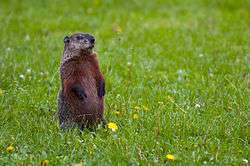
The time spent observing groundhogs by field biologists represents only a small fraction of time devoted to the field research.[12] W.J. Schoonmaker reports that groundhogs may hide when they see, smell or hear the observer.[5]:41–43 Ken Armitage, marmot researcher, states that the social biology of the groundhog is well understudied.[13] Despite their heavy-bodied appearance, groundhogs are accomplished swimmers and occasionally climb trees when escaping predators or when they want to survey their surroundings.[14] They prefer to retreat to their burrows when threatened; if the burrow is invaded, the groundhog tenaciously defends itself with its two large incisors and front claws. Groundhogs are generally agonistic and territorial among their own species, and may skirmish to establish dominance.[15] Outside their burrow, individuals are alert when not actively feeding. It is common to see one or more nearly-motionless individuals standing erect on their hind feet watching for danger. When alarmed, they use a high-pitched whistle to warn the rest of the colony, hence the name "whistle-pig".[9][16] Groundhogs may squeal when fighting, seriously injured, or caught by a predator.[16] Other sounds groundhogs may make are low barks and a sound produced by grinding their teeth.[16] When groundhogs are frightened, the hairs of the tail stand straight up, giving the tail the appearance of a hair brush. David P. Barash wrote he witnessed only two occasions of upright play-fighting among woodchucks and that the upright posture of play-fighting involves sustained physical contact between individuals and may require a degree of social tolerance virtually unknown in M. monax. He said it was possible to conclude, alternatively, that upright play-fighting is part of the woodchuck's behavioral repertory but rarely shown because of physical spacing and/or low social tolerance.[17]
Diet
Mostly herbivorous, groundhogs eat primarily wild grasses and other vegetation, including berries and agricultural crops, when available.[15] Clover, alfalfa, dandelion, and coltsfoot are among preferred groundhog foods.[5]:93 Groundhogs also eat grubs, grasshoppers, insects, snails and other small animals, but are not as omnivorous as many other Sciuridae. Like squirrels, they also have been observed sitting up eating nuts such as shagbark hickory, but unlike squirrels, do not bury them for future use. Zoologists believe that groundhogs get most of the water they need from the juices of food-plants, aided by their sprinkling with rain or dew.[5]:85[18]
Burrows
Groundhogs are excellent burrowers, using burrows for sleeping, rearing young, and hibernating. W.J. Schoonmaker excavated 11 dens finding the earth removed from these averaged six cubic feet or four and eight-tenths cubic bushels per den. The longest burrow was 24 feet plus 2 short side galleries. The amount of soil taken from this den was eight cubic bushels and it weighed 640 pounds. The average weight of the earth taken from all eleven dens was 384 pounds.[19] Though groundhogs are the most solitary of the marmots, several individuals may occupy the same burrow. Groundhog burrows usually have two to five entrances, providing groundhogs their primary means of escape from predators. Burrows are particularly large, with up to 14 metres (46 ft) of tunnels buried up to 1.5 metres (5 ft) underground, and can pose a serious threat to agricultural and residential development by damaging farm machinery and even undermining building foundations.[9] In a June 7, 2009 Humane Society of the United States article, "How to Humanely Chuck a Woodchuck Out of Your Yard", John Griffin, director of Humane Wildlife Services, stated you would have to have a lot of woodchucks working over a lot of years to create tunnel systems that would pose any risk to a structure.
The burrow is used for safety, retreat in bad weather, hibernating, sleeping, love nest, and nursery. In addition to the nest, there is an excrement chamber. The nest chamber may be about twenty inches to three feet below ground surface. It is about sixteen inches wide and fourteen inches high. There are typically two burrow openings or holes. One is the main entrance, the other a spy hole. Description of the length of the burrow often includes the side galleries of the burrow. Excluding the side galleries, Schoonmaker reports the longest was twenty-four feet, with the average length of eleven dens dug out to be fourteen feet.[5]:104–105 W.H. Fisher investigated nine burrows, finding the deepest point to be forty-nine inches down. The longest, including side galleries, was forty-seven feet eleven and one half inches.[4]:306
Bachman mentioned that when the young groundhogs are a few months old, they prepare for separation, digging a number of holes in the area of their early home. Some of these holes were only a few feet deep and never occupied but the numerous burrows gave the impression that groundhogs live in communities.[4]:318
Hibernation
Groundhogs are one of the few species that enter into true hibernation, and often build a separate "winter burrow" for this purpose. This burrow is usually in a wooded or brushy area and is dug below the frost line and remains at a stable temperature well above freezing during the winter months. In most areas, groundhogs hibernate from October to March or April, but in more temperate areas, they may hibernate as little as three months.[20] To survive the winter, they are at their maximum weight shortly before entering hibernation. They emerge from hibernation with some remaining body fat to live on until the warmer spring weather produces abundant plant materials for food. Groundhogs are mostly diurnal, and are often active early in the morning or late afternoon.[21]
Reproduction
Usually groundhogs breed in their second year, but a small proportion may breed in their first. The breeding season extends from early March to mid- or late April, after hibernation. A mated pair remains in the same den throughout the 31- to 32-day[22] gestation period. As birth of the young approaches in April or May, the male leaves the den. One litter is produced annually, usually containing two to six blind, hairless and helpless young. Groundhog mothers introduce their young to the wild once their fur is grown in and they can see. At this time, if at all, the father groundhog comes back to the family.[4]:316 They encourage their young to copy their behaviors and during this time may differ from usual routines. By the end of August, the family breaks up; or at least, the larger number scatter, to burrow on their own.[4]:318
Relationship with humans
Both their diet and habit of burrowing make them serious nuisance animals around farms and gardens. They will eat many commonly grown vegetables, and their burrows can destroy farm ponds and undermine foundations and there is a thriving business exterminating them. Their preferred habitat of grassy areas near woods also makes them abundant along roads and highways where they often become the victims of passing cars.
Very often the dens of groundhogs provide homes for other animals including skunks, red foxes, and cottontail rabbits. The fox and skunk feed upon field mice, grasshoppers, beetles and other creatures that destroy farm crops. In aiding these animals, the woodchuck indirectly helps the farmer. In addition to providing homes for itself and other animals, the groundhog aids in soil improvement by bringing subsoil to the surface. The groundhog is also a valuable game animal and is considered a difficult sport when hunted in a fair manner.[5]:129–131
A report in 1833 by the New Hampshire Legislative Woodchuck Committee illustrates the attitude of some people towards this animal. In part, the report states: "The woodchuck, despite its deformities both of mind and body, possess some of the amenities of a higher civilization. It cleans its face after the manner of the squirrels, and licks its fur after the manner of a cat. Your committee is too wise, however, to be deceived by this purely superficial observation of better habits. Contemporaneous with the ark, the woodchuck has not made any material progress in social science, and it is now too late to reform the wayward sinner. The average age of the woodchuck is too long to please your committee.... The woodchuck is not only a nuisance, but also a bore. It burrows beneath the soil, and then chuckles to see a mowing machine, man and all, slump into one of these holes and disappear....[4]:328 Your committee is confident that a small bounty will prove of incalculable good; at all vents, even as an experiment, it is certainly worth trying; therefore your committee would respectfully recommend that the accompanying bill be passed."[5]:133
Groundhogs may be raised in captivity, but their aggressive nature can pose problems. Doug Schwartz, a zookeeper and groundhog trainer at the Staten Island Zoo, has been quoted as saying "They’re known for their aggression, so you’re starting from a hard place. Their natural impulse is to kill ’em all and let God sort ’em out. You have to work to produce the sweet and cuddly."[23] Wildlife rehabilitation is the treatment and care of injured, orphaned, or sick wild animals so that they can be released back to the wild. In the event an injured, orphaned, or sick groundhog is found, contact a wildlife rescue center or rehabilitator.
In the United States and Canada, the yearly February 2 Groundhog Day celebration has given the groundhog recognition and popularity, as has the movie of the same name. The most popularly known of these groundhogs are Punxsutawney Phil, Wiarton Willie, Jimmy the Groundhog, and Staten Island Chuck kept as part of Groundhog Day festivities in Punxsutawney, Pennsylvania; Wiarton, Ontario; Sun Prairie, Wisconsin, and Staten Island respectively. Famous Southern groundhogs include Smith Lake Jake from Graysville, Alabama and General Beauregard Lee, based at the Yellow River Game Ranch outside Atlanta, Georgia.
Groundhogs are used in medical research on hepatitis B-induced liver cancer. A percentage of the woodchuck population is infected with the woodchuck hepatitis virus (WHV), similar to human hepatitis B virus. Humans do not receive hepatitis from woodchucks with WHV but the virus and its effects on the liver make the woodchuck the best available animal for the study of viral hepatitis in humans. The only other animal model for hepatitis B virus studies is the chimpanzee, an endangered species.[24]
Groundhog burrows have been known to reveal at least one archaeological site, the Ufferman Site in the U.S. state of Ohio.[25] Although archaeologists have never excavated the Ufferman Site, numerous artifacts have been found because of the activities of local groundhogs. They favor the loose soil of the esker upon which the site lies, and their many diggings for their burrows have brought to the surface significant numbers of human and animal bones, pottery, and bits of stone.[25] Woodchuck remains were found in the Indian mounds at Aztalan, Jefferson County, Wisconsin.[10]
Robert Frost's poem "A Drumlin Woodchuck" uses the imagery of a groundhog dug in to a small ridge as a metaphor for his emotional reticence. A groundhog figures prominently in the movie Groundhog Day.
References
- ↑ Linzey, A. V.; Hammerson, G. (NatureServe) & Cannings, S. (NatureServe) (2008). "Marmota monax". IUCN Red List of Threatened Species. Version 2014.3. International Union for Conservation of Nature. Retrieved 7 January 2015.
- ↑ "Marmota monax". North American Mammals. Smithsonian Institution. Retrieved 1 February 2015.
- ↑ Thorington, R.W., Jr.; Hoffman, R.S. (2005). "Family Sciuridae". In Wilson, D.E.; Reeder, D.M. Mammal Species of the World: A Taxonomic and Geographic Reference (3rd ed.). Johns Hopkins University Press. p. 802. ISBN 978-0-8018-8221-0. OCLC 62265494.
- 1 2 3 4 5 6 Seton, Ernest Thompson (1929). Lives of Game Animals, Volume IV. Doubleday, Doran & Company.
- 1 2 3 4 5 6 7 Schoonmaker, W.J. (1966). The World of the Woodchuck. J.B. Lippincott. ISBN 1135544832.
- ↑ Marmota monax (Linnaeus); Woodchuck. Pick4.pick.uga.edu. Retrieved on 2011-09-15.
- ↑ Marmota Monax: Woodchuck. animaldiversity.com. Retrieved on 2015-02-24.
- ↑ Lyrics and Words for Children's Nursery Rhymes and Songs. BusSongs.com. Retrieved on 2011-09-15.
- 1 2 3 Light, Jessica E. "Animal Diversity Web: Marmota monax". University of Michigan Museum of Zoology. Retrieved 2009-07-14.
- 1 2 3 Jackson, Hartley H T (1961). Mammals of Wisconsin. University of Wisconsin Press.
- ↑ Walkers Mammals of the World, Vol. 1, 1991. page 569
- ↑ Barash, David (1989) Marmots, Social Behavior and Biology. Stanford University Press. Preface p. xv. ISBN 0804715343.
- ↑ Special feature "The Study of Groundhogs: A Real Life Look at Marmots", Movie "Groundhog Day" 15th Anniversary Edition.
- ↑ Chapman, J.A.; Feldhammer, G.A. (1982). Wild Mammals of North America, Biology, Management, Economics. Johns Hopkins University Press. ISBN 0801823536.
- 1 2 Whitaker, John O; Hamilton, W J. (1998). Mammals of the Eastern United States. Cornell University Press. ISBN 0-8014-3475-0.
- 1 2 3 Hinterland Who's Who ("Canadian Wildlife Service: Mammals: Woodchuck"). Hww.ca. Retrieved on 2011-09-15.
- ↑ Marmots, Social Behavior and Biology, 1989, David P. Barash, Stanford University Press, p. 97.
- ↑ Lives of Game Animals, 1929, Volume 1V, p. 30
- ↑ Schoonmaker pages 108-109
- ↑ Woodchucks in Rhode Island. (PDF) dem.ri.gov. Retrieved on 2011-09-15.
- ↑ Woodchuck, Illinois University
- ↑ Woodchuck. Marmota monax. (PDF). North Caroline Wildlife.
- ↑ Newman, Andy (2007-12-01). "Grooming a Weatherman for his TV Debut, and Hoping He Doesn't Bite The Host". The New York Times.
- ↑ Segelken, Roger Cornell (February 1, 1966) "At Cornell, groundhog is harbinger of health". CornellChronicle. Cornell University
- 1 2 Owen, Lorrie K. (ed.) (1999). Dictionary of Ohio Historic Places. Vol. 1. St. Clair Shores: Somerset, p. 328.
Further reading
- Bezuidenhout, A. J. (Abraham Johannes) and Evans, Howard E. (Howard Edward). Anatomy of the woodchuck (Marmota monax). Lawrence, KS: American Society of Mammalogists, 2005. ISBN 9781891276439. Online at doi:10.5962/bhl.title.61270
External links
| Wikimedia Commons has media related to Marmota monax. |
| Wikispecies has information related to: Marmota monax |
- Woodchuck, Hinterland Who's Who
- Woodchuck (Groundhog), Missouri Conservation Commission
